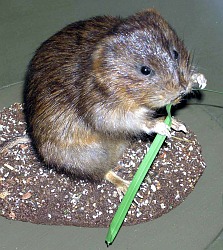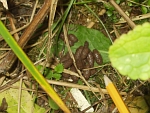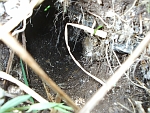Watervoles in the parish of Overton
 The object of this survey was to examine the entire length of the River Test within Overton parish searching for signs of the presence of water voles (Arvicola terrestris).
The object of this survey was to examine the entire length of the River Test within Overton parish searching for signs of the presence of water voles (Arvicola terrestris).
The population of water voles in the U.K. has been declining throughout the 20th century and has undergone a particularly severe decline over the last 20 years such that the water vole has become Britain's most rapidly declining mammal. Similarly, water voles were once commonly seen along the river Test in Overton but they are rarely seen nowdays.
Methods
The survey took place between October and December 2006. The stretch of river that is within the parish boundaries was divided into 15 sections from the source of the river at Ashe to the parish boundary at Laverstoke Park (download map - gif, 318kB). For each section a team of volunteers from O.B.S. walked along the bank and recorded evidence of water vole activity:
- Direct Sightings.
- Latrines: Water vole latrines are sites where droppings and scent are deposited to mark territory. (Picture 1 below)
- Burrows: Water voles produce a system of burrows along the water's edge often extending back into the bank for several metres. (Picture 2 below)
- Pathways: Water voles will produce pathways in vegetation close to the water's edge leading to burrow entrances and feeding sites. (Picture 3 below)
- Feeding sites: Small piles of feeding remains, typically up to 10cm long with a distinctive angled cut at the end. (Picture 4 below)
- Cropped grass 'lawns': Areas of short cropped grass where female water voles with young in the burrow feed without leaving the immediate area of their nest.
 2.
2. 3.
3. 4.
4.
Results
Although only one water vole was seen during the survey, numerous burrows, latrines and feeding sites were recorded but numbers varied widely across sections of the river. From these figures we estimated the possible numbers of water vole present (download map - gif, 319kB). We found that water voles were almost entirely absent from certain stretches of the river but comparatively plentiful in others:

- Laverstoke to Southington Lane: 4-5
- Southington Lane to Bridge Street: 1-2
- Bridge Street to Kingsclere Road: 1-2
- Kingsclere Road to Station Road: 21-22
- Station Road to Straight Lane: 8-9
- Straight Lane to Ashe: 1-2
Conclusion
Sections where signs of water voles were found were almost invariably associated with the presence of steep earth banks which had not been reinforced and thick bank side vegetation composed of sedges, reeds and tall grasses. Water voles were absent from areas where the water level was very low, where banks were densely shaded by trees, where bank side grasses, reeds and sedges were missing or where banks had been reinforced with hard materials.
A detailed report with all the results of this water vole survey is available to download from our online library in the 'resources' section of this web site.
